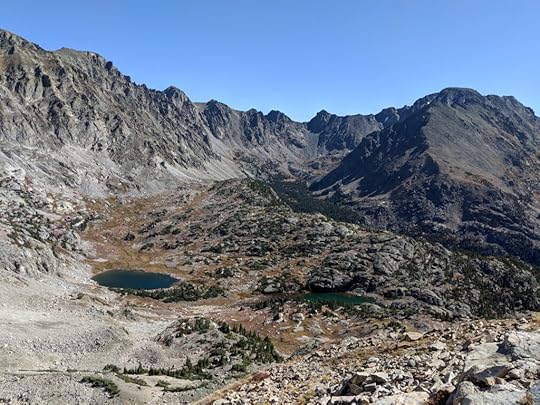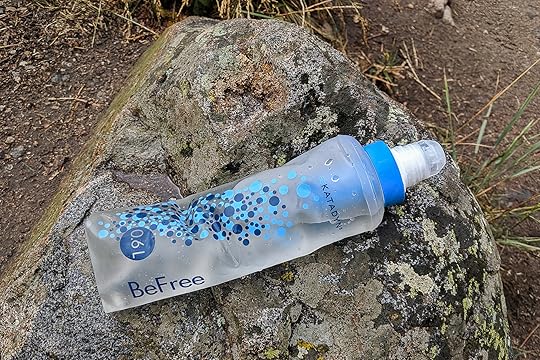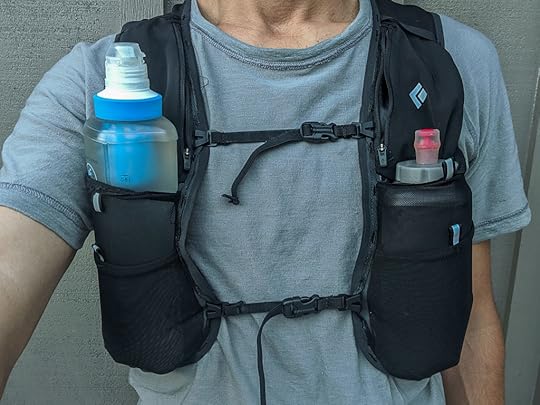Clean water on-the-run || Review: Katadyn BeFree Collapsible Filter Bottle
Motivated by the impending arrival of winter, last month and earlier this month I undertook five of the most fun and most adventurous trail runs of my life.
Natural water sources were abundant during these 5- to 11-hour efforts, but I was skeptical of their quality. By late-summer in Rocky Mountain National Park and the Indian Peaks Wilderness, flow rates are low, and droppings from elk, moose, and deer (and sometimes humans) litter the tundra and forest floor.
To reduce my risk of waterborne cooties, I used the Katadyn BeFree Collapsible Water Filter Bottle 20-oz. It was sent to me last year by a media representative, but unfortunately I didn’t get out for any all-day mountain runs until recently.
 The BeFree was ideal for several recent 5- to 11-hour outings in Rocky Mountain National Park and the Indian Peaks Wilderness (photo).
The BeFree was ideal for several recent 5- to 11-hour outings in Rocky Mountain National Park and the Indian Peaks Wilderness (photo).Review: Katadyn BeFree Collapsible Water Filter Bottle
The Katadyn BeFree Collapsible Water Filter Bottle provides potable water on-the-go, with the refill-to-drink process taking as little as 30 seconds. It’s available in two sizes:
BeFree 0.6-liter/20-oz ($40, 2.6 oz confirmed), andBeFree 1.0-liter/33.8-oz ($45, 3.0 oz estimated)
The smaller size, which has an actual capacity of 0.71 liters or 25 ounces, is ideal for long trail runs or fast day-hikes in areas with natural water sources, as well as for lightly supported trail races. While the BeFree has some room for improvement, I think it’s very well suited for this application and I’d heartily recommend it.
 The Katadyn BeFree Collapsible Water Filter Bottle 20 oz is ideally suited for long trail runs and fast day hikes in areas with natural water sources.
The Katadyn BeFree Collapsible Water Filter Bottle 20 oz is ideally suited for long trail runs and fast day hikes in areas with natural water sources.One unique feature of the BeFree is its form factor. The filter is inside the container, rather than protruding from the top like the Sawyer Squeeze ($35, 3 oz). When empty, it’s only marginally more bulky than the filter-less flasks popular among trail runners. When about three-fourths full (or less), the 0.6-liter/20-oz size fits in the front pocket of a running vest.
 When collapsed, the BeFree Bottle is only marginally more bulky than a filter-less flask like the UD Body Bottle.
When collapsed, the BeFree Bottle is only marginally more bulky than a filter-less flask like the UD Body Bottle.The filter extracts protozoa and bacteria, which are more commonly found in backcountry water than viruses, which are too small to filter out. Out of the box, the BeFree has an astounding flow rate of about two liters per minute. There’s very little resistance in the system, and you may wonder if it’s actually doing anything.
The flow rate decreases with use, but can be quickly and easily cleaned in the field, without needing any accessories (e.g. back flush syringe). Some long-term users (read through the comments) have complained about permanently diminished performance, which is not something that I have yet seen but which I will keep tabs on.
Katadyn could better optimize the BeFree for trail running by:
Advertising correctly the BeFree’s true water capacity,Redesigning the cap, andOffering it in other bottle types and sizes.
Key product specs
Removes protozoa and bacteria, but not viruses2.7 oz for filter and 0.6-liter flask2 liters per minute flow rateField clean-able without accessories$40 MSRP for the 0.6-liter sizeMore information
Optimal uses
The BeFree is suitable for long runs in areas with natural water sources, so that you can refill along the way. I’d also consider it for lightly supported trail races, so that I could confidently top off between aid stations.
For runs shorter than one to two hours, when refilling is unnecessary, a standard filter-less bottle will suffice. For runs in areas without natural water sources, the BeFree will not help. And for runs in areas with extremely contaminated water sources, I’d insist on a two-step treatment process, filtering it first and then knocking it with chemicals like Aquamira drops ($15, less than 2 oz).
For backpacking, I’d prefer a different bottle type, and possibly a different treatment system, depending on the setting and group size. Personally, I normally carry:
A 1-liter disposable plastic bottle (e.g. smartwater), which is easier to refill and drink from than an amorphous flask;A 2.4-liter collapsible PlatyBottle, for long dry stretches and for camp use; and,Aquamira drops, which I’ve trusted for years and which will quickly treat large quantities of water (e.g. water for 10 people).
Room for improvement
I’m not aware of another product that better addresses the needs of trail runners than the BeFree, in terms of effectiveness, speed, and size/weight. But it could be more optimized for this purpose, with changes that are so obvious that I wonder if Katahdyn even sought the feedback of trail runners during the design process.
1. Advertise correctly its capacity.
The BeFree 0.6L (or 20 oz, for Imperial audiences) has a true capacity of 0.71 liters or 25 oz. That’s a 17 to 25 percent error!
 The true capacity of the 0.6L/20oz BeFree is 0.71L or 25 oz (1*16 + 9).
The true capacity of the 0.6L/20oz BeFree is 0.71L or 25 oz (1*16 + 9).Yes, this small difference matters. When trail running, a 0.6-liter (20-oz) flask is borderline unmanageable. But a 0.7-liter (25-oz) flask is most definitely impractical — it will not sit nicely in the front pocket of any running vest, such as my Black Diamond Distance or Ultimate Direction AK Mountain Vest 3.0. Without proper support, it annoyingly bounces all over the place.
To make the 0.6-liter/20-oz work for trail running, I had two solutions:
Fill it no more than two-thirds to three-fourths full, orFill it entirely, but then drink one-fourth to one-third of the water before storing it away.
 The 0.6-liter BeFree (actual capacity 0.7 liters) does not fit well in the Black Diamond Distance Vest. For comparison, notice the 500-ml flask to the right.
The 0.6-liter BeFree (actual capacity 0.7 liters) does not fit well in the Black Diamond Distance Vest. For comparison, notice the 500-ml flask to the right. Nor does it fit well in the Ultimate Direction AK Mountain Vest 3.0. A true 500-ml flask fits much better.
Nor does it fit well in the Ultimate Direction AK Mountain Vest 3.0. A true 500-ml flask fits much better.2. Redesign the mouthpiece.
Currently, the free-flow spout is covered with a hinged cap. This cap requires two-hand operation: one hand must hold the flask while the other hand releases the cap. And it seems prone to snapping, which would ruin the filter — without the pressure of the cap, water would freely exit through the spout.
As an alternative to the current design, I’d recommend a more conventional push/pull cap or bite valve, both of which are time-tested and can be operated with just one hand (and a mouth).
 The hinged cap requires two-hand operation and seems vulnerable to snapping off.
The hinged cap requires two-hand operation and seems vulnerable to snapping off.3. Offer the BeFree in other bottle types and sizes.
As previously stated, a 0.7-liter flask is sub-optimal for trail running, because of its unwieldy size and its incompatibility with modern running vests. A true 0.5-liter flask would be much better.
I’d also like to see the BeFree added to a 20-oz soft-sided squeeze bottle. This type does not collapse like the flasks, but it’s rigidity is better for larger volumes. It’s also more easily refillable from non-flowing sources like lakes and small pools.
 The flask is easily filled in flowing water sources, but not in non-flowing sources like lakes and small pools.
The flask is easily filled in flowing water sources, but not in non-flowing sources like lakes and small pools.Leave a comment!
Have questions about the BeFree Filter Bottle?Have an experience with it that you’d like to share?What other treatment methods have you tried for long trail runs?
Disclosure. I strive to offer field-tested and trustworthy information, insights, and advice. I have no financial affiliations with or interests in any brands or products, and I do not publish sponsored content
This website is supported by affiliate marketing, whereby in exchange for referral traffic I receive a small commission from select vendors, at no cost to the reader. This post contains affiliate links.
Buy now: Katadyn BeFree Collapsible Water Filter Bottle
The post Clean water on-the-run || Review: Katadyn BeFree Collapsible Filter Bottle appeared first on Andrew Skurka.



